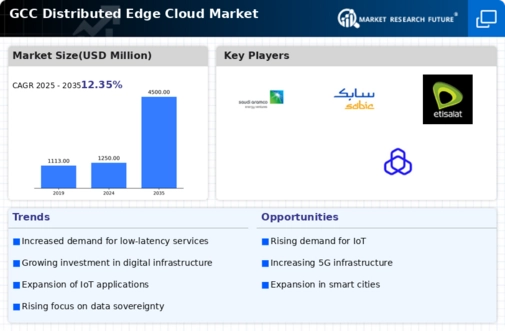Expansion of 5G Networks
The rollout of 5G networks across the GCC is poised to be a critical driver for the distributed edge-cloud market. With its promise of ultra-fast data transmission speeds and enhanced connectivity, 5G technology is expected to enable a plethora of new applications and services that require robust edge computing capabilities. The GCC region has seen substantial investments in 5G infrastructure, with projections indicating that the number of 5G connections could reach 50 million by 2026. This expansion is likely to create a fertile environment for the distributed edge-cloud market, as businesses seek to leverage the high bandwidth and low latency offered by 5G. Consequently, organizations are expected to adopt edge-cloud solutions to optimize their operations and improve service delivery, thereby driving market growth.
Rising Demand for Low Latency Services
The distributed edge-cloud market is experiencing a notable surge in demand for low latency services, particularly within the GCC region. As businesses increasingly rely on real-time data processing and analytics, the need for reduced latency becomes paramount. This trend is driven by sectors such as finance, healthcare, and telecommunications, where milliseconds can significantly impact performance and user experience. According to recent estimates, the demand for low latency solutions in the GCC is projected to grow by approximately 30% annually. This growth is likely to propel investments in edge computing infrastructure, thereby enhancing the capabilities of the distributed edge-cloud market. Companies are now prioritizing the deployment of edge nodes closer to end-users to facilitate faster data processing and response times, which is essential for maintaining competitive advantage.
Increased Focus on Smart City Initiatives
The distributed edge-cloud market is significantly influenced by the growing emphasis on smart city initiatives within the GCC. Governments in the region are investing heavily in technology to enhance urban living, improve infrastructure, and streamline public services. This trend is likely to drive the demand for distributed edge-cloud solutions, as they facilitate the processing of vast amounts of data generated by smart city applications, such as traffic management, waste management, and public safety. Reports suggest that investments in smart city projects in the GCC could exceed $100 billion by 2030. As cities become more interconnected, the need for efficient data processing and real-time analytics will likely propel the adoption of distributed edge-cloud technologies, thereby fostering innovation and improving quality of life.
Growing Adoption of Artificial Intelligence
The integration of artificial intelligence (AI) technologies is emerging as a significant driver for the distributed edge-cloud market in the GCC. Organizations are increasingly leveraging AI to enhance operational efficiency, improve decision-making, and deliver personalized customer experiences. The distributed edge-cloud market provides the necessary infrastructure to support AI applications, enabling real-time data processing and analytics at the edge. As per recent forecasts, the AI market in the GCC is expected to reach $10 billion by 2025, with a substantial portion of this growth attributed to edge computing capabilities. This trend suggests that businesses will likely invest in distributed edge-cloud solutions to harness the power of AI, thereby driving market expansion and fostering innovation across various sectors.
Emphasis on Data Sovereignty and Localization
The distributed edge-cloud market is increasingly shaped by the emphasis on data sovereignty and localization within the GCC. Governments are implementing regulations that require data generated within their borders to be stored and processed locally. This regulatory landscape is compelling organizations to adopt distributed edge-cloud solutions that comply with these requirements. As a result, businesses are likely to invest in local data centers and edge computing infrastructure to ensure compliance and enhance data security. The market for data localization in the GCC is projected to grow significantly, with estimates suggesting a potential increase of 25% in demand for localized cloud services by 2026. This trend indicates that the distributed edge-cloud market will play a crucial role in helping organizations navigate the complexities of data sovereignty while optimizing their operations.

















Leave a Comment